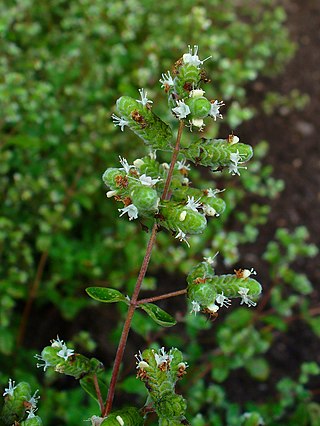
Marjoram is a cold-sensitive perennial herb or undershrub with sweet pine and citrus flavours. In some Middle Eastern countries, marjoram is synonymous with oregano, and there the names sweet marjoram and knotted marjoram are used to distinguish it from other plants of the genus Origanum. It is also called pot marjoram, although this name is also used for other cultivated species of Origanum.

Oregano is a species of flowering plant in the mint family Lamiaceae. It was native to the Mediterranean region, but widely naturalised elsewhere in the temperate Northern Hemisphere.
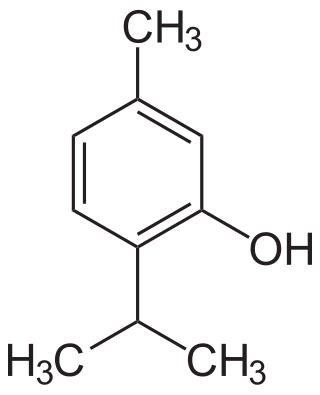
Thymol, C10H14O, is a natural monoterpenoid phenol derivative of p-Cymene, isomeric with carvacrol, found in oil of thyme, and extracted from Thymus vulgaris, ajwain, and various other plants as a white crystalline substance of a pleasant aromatic odor and strong antiseptic properties. Thymol also provides the distinctive, strong flavor of the culinary herb thyme, also produced from T. vulgaris. Thymol is only slightly soluble in water at neutral pH, but it is extremely soluble in alcohols and other organic solvents. It is also soluble in strongly alkaline aqueous solutions due to deprotonation of the phenol. Its dissociation constant (pKa) is 10.59±0.10. Thymol absorbs maximum UV radiation at 274 nm.
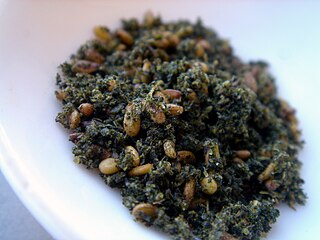
Za'atar is a culinary herb or family of herbs. It is also the name of a spice mixture that includes the herb along with toasted sesame seeds, dried sumac, often salt, as well as other spices. As a family of related Middle Eastern herbs, it contains plants from the genera Origanum (oregano), Calamintha, Thymus, and Satureja (savory) plants. The name za'atar alone most properly applies to Origanum syriacum, considered in biblical scholarship to be the ezov of the Hebrew Bible, often translated as hyssop but distinct from modern Hyssopus officinalis.
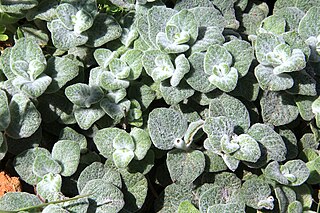
Origanum dictamnus, the dittany of Crete, Cretan dittany or hop marjoram, is a tender perennial plant that grows 20–30 cm high. It is known in Greek as δίκταμο or in the Cretan dialect as έρωντας. It is a therapeutic and aromatic plant that grows wild only on the mountainsides and gorges of the Greek island of Crete. It is widely used for food flavouring and medicinal purposes, in addition to featuring as an ornamental plant in gardens. This small, lanate shrub is easily recognised by the distinctive soft, woolly covering of white-grey hair on its stems and round green leaves, giving it a velvety texture. Its tiny rose-pink flowers are surrounded by brighter purple-pink bracts in summer and autumn. The dittany is classified as vulnerable on the IUCN Red List of Threatened Plant Species 1997.
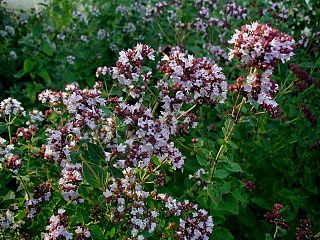
Origanum is a genus of herbaceous perennials and subshrubs in the family Lamiaceae, native to Europe, North Africa, and much of temperate Asia, where they are found in open or mountainous habitats. A few species also naturalized in scattered locations in North America and other regions.

Ariocarpus is a small genus of succulent, subtropical plants of the family Cactaceae.
Carvacrol, or cymophenol, C6H3(CH3)(OH)C3H7, is a monoterpenoid phenol. It has a characteristic pungent, warm odor of oregano.

The Cactoideae are the largest subfamily of the cactus family, Cactaceae. Around 80% of cactus species belong to this subfamily. As of August 2018, the internal classification of the family Cactaceae remained uncertain and subject to change. A classification incorporating many of the insights from the molecular studies was produced by Nyffeler and Eggli in 2010. Various revisions have been published since, e.g. to the tribe Hylocereeae and the tribe Echinocereeae. Classifications remained uncertain as of March 2019.

Ariocarpus fissuratus is a species of cactus found in small numbers in northern Mexico and Texas in the United States. Common names include living rock cactus, false peyote, chautle, dry whiskey and star cactus.

Origanum syriacum; syn. Majorana syriaca, bible hyssop, Biblical-hyssop, Lebanese oregano or Syrian oregano, is an aromatic perennial herb in the mint family, Lamiaceae.

Ariocarpus agavoides is a species of cactus. It is endemic to Mexico. It grows in dry shrubland in rocky calcareous substrates.

Ariocarpus bravoanus is a species of cactus which is endemic to San Luis Potosí in Mexico. It grows in dry shrubland habitat on limestone substrates. It is endangered due to overcollecting.

Ariocarpus kotschoubeyanus is a species of plant in the family Cactaceae.

Ariocarpus scaphirostris is a species of plant in the family Cactaceae. The Ariocarpus scaphirostris was originally called Ariocarpus scapharostrus in the 1930. D. R. Hunt, however, changed it to Ariocarpus scaphirostris.

Dalbergia retusa is a plant species in the genus Dalbergia found in Pacific regions of Central America, ranging from Panama to southwestern Mexico. It produces the cocobolo wood. It is a fair-sized tree, reported to reach 20–25 m in height. This is probably the species contributing most of the wood in the trade. Because of the wood's great beauty and high value, the trees yielding this wood have been heavily exploited and are now rare outside national parks, reserves, and plantations.
Many cacti are known to be psychoactive, containing phenethylamine alkaloids such as mescaline. However, the two main ritualistic (folkloric) genera are Echinopsis, of which the most psychoactive species is the San Pedro cactus, and Lophophora, with peyote being the most psychoactive species. Several other species pertaining to other genera are also psychoactive, though not always used with a ritualistic intent.

Origanum onites, the Cretan oregano, Greek oregano, pot marjoram or Ellinikí rίgani in Greek, is a plant species in the genus Origanum found in Sicily, Greece and Turkey. It has similar flavors as oregano. Its essential oil can be distinguished from other species such as Greek oregano. It has antimicrobial activities.
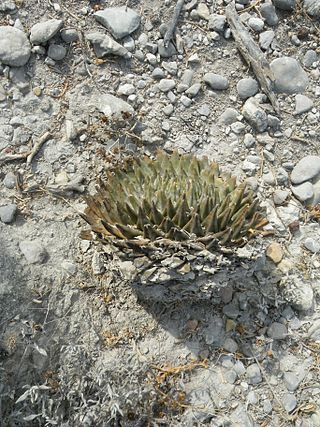
Ariocarpus trigonus is a species of flowering plant in the family Cactaceae, native to Mexico.
















